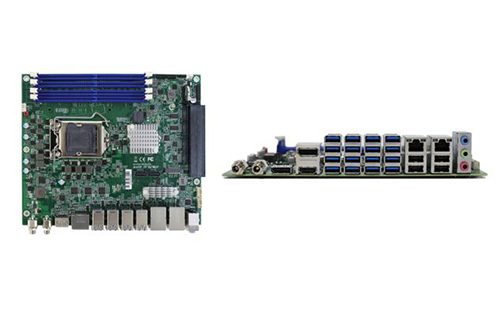- August 19, 2021
- News
Summary
The demand for USB ports has increased exponentially due to the sheer number of these peripheral devices and gadgets, each of which requires the ubiquitous USB ports for communication and connection.

Technology has a voracious appetite that is constantly whetted by users’ demands for newer, faster, safer and more versatile applications and peripherals that feed hardware and software using I/O connections such as the most-favored USB ports. The demand for USB ports has increased exponentially due to the sheer number of these peripheral devices and gadgets, each of which requires the ubiquitous USB ports for communication and connection.
In the past, companies have fulfilled their needs by using an additional USB hub or splitter. Unfortunately, this is merely a patch and not a long-term solution since there are disadvantages to this method, such as latency because the hub shares bandwidth with its ports, which, along with the constant need for bandwidth allocation, ultimately affects the hub’s performance. This often results in a slower system, with less flexibility and unhappy users.
The key to solving these issues lies in the ability of a vendor to find new ways to fix old problems.
Portwell’s new industrial FlexATX Board more than meets the demand
To meet the demand for greater USB ports without latency, American Portwell Technology recently announced PEB-9783G2AR, a new industrial FlexATX board based on the latest 10th Generation Intel® Xeon® W/Core™ processors (formerly Comet Lake-S Platform) with W480E/Q470E chipset that features up to 10 cores/20 threads in LGA 1200 socket.
This device resolves the latency and bandwidth allocation problems because it ensures that each of the 20x USB ports it supports is configured for maximum performance by using separate chips and PCIe lanes, with one PCIe x16 slot still available for other expansion, such as a GPU card.
PEB-9783G2AR can enhance connectivity for applications such as Industrial Automation: automated guided vehicle (AGV); supporting multiple USB cameras for robot sorting; vehicle navigation; manufacturing robots; factory process control; and smart transportation. It meets the demands of chiropractic examiners in the Medical/Healthcare Market; the Networking/IoT demands of the datacenter, software-defined USB radios and IoT security devices; and entertainment within the Machinery/ Manufacturing industry.
PEB-9783G2AR takes inherent bandwidth limitation in stride
While PEB-9783G2AR is designed to support 20x USB ports, and 16x ports support speeds up to the USB 3.0 specification, there are some inherent bandwidth limitations with the chipset that limits some of the port’s ability to operate at maximum speed when fully loaded. The new FlexATX board helps alleviate this problem by arranging the ports into a three-tier system to maximize bandwidth so the user can prioritize the usage based on their application. (See Figure 1 below.)

For example, the USB ports listed as Tier 1 are initiated by ASM3142 USB controllers and these 6x USB ports have a greater priority than another 10x USB ports routed from PCH. Four USB 2.0 ports are reserved for Keyboard, Mouse, and other lower speed USB devices.
In this configuration, a question can arise that, if a user wishes to use 10x USB ports simultaneously, to which ports should the user connect to obtain the highest speeds? American Portwell’s experts suggest the following arrangement: 6x from Tier-1 and 4x from Tier-2. This generates the maximum speed for all USB ports at the same time.
PEB-9783G2AR: The first of its kind
PEB-9783G2AR is the first embedded motherboard with 20x USB I/O ports on the market and provides flexibility and enhances connectivity, communication and control of peripheral devices.
Among the board’s many features is the ability to support 20x USB ports, 16 of them support USB 3.0 in various specification, 6 of them (Tier 1) maintain USB 3.2 Gen 1 speed all the time, and 10 of them will provide USB 3.2 Gen 2 (Tier 2) and Gen 1 (Tier 3) speed depends on loading and bandwidth availability, 4 are reserved for legacy USB 2.0 ports for Keyboard/ Mouse and other low speed devices which are separated to allow competing with the high speed devices. This arrangement allowing users to connect to many peripheral devices such as cameras that can be used for robot and vehicle navigation. Please see details in Table 1 below.

Other features include dual-channel DDR4 2400/2666 ECC/Non-ECC SDRAM on four Long-DIMM sockets up to 128GB; dual Gigabit Ethernet, 2x SATA III and audio jack on rear; 1x PCIe 3.0 x16 (0r 2 x8 or 1 x8 + 2 x4 signal); 1 x M.2 key M 2280 for SSD; 4x serial ports, including 2x RS-232 and 2x RS-232/422/485 (BIOS configurable); triple independent 4K displays including 2x DP 1.4 and 1x HDMI; dual DC 12V input, supports AT/ATX mode; and onboard TPM 2.0 for security. These features are designed to help users build a stable, high-performing system.
The FlexATX board is powered by dual 12V DC input (up to 150W each) that can provide all 20x USB ports with 16x USB 3.2 Gen 1 power spec (900 mA) and 4x USB 2.0 power spec (500 mA). In the event that all ports are at maximum loading and maximum speed, ports are given a tier system (as in Figure 1) to aid the user to prioritize each device and application.
Did you enjoy this great article?
Check out our free e-newsletters to read more great articles..
Subscribe

